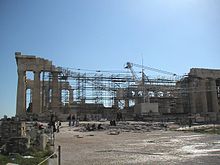Dimension stone
Another important selection criterion is durability: the time measure of the ability of dimension stone to endure and to maintain its essential and distinctive characteristics of strength, resistance to decay, and appearance.
These rock types are more commonly known as granite, limestone, marble, travertine, quartz-based stone (sandstone, quartzite) and slate.
A polished finish gives the surface a high luster and strong reflection of incident light (almost mirror-like).
While common colors used in some of the major applications are listed below, there is an extraordinarily wide range of colours, available in thousands of patterns.
These patterns are created by geological phenomena such as mineral grains, inclusions, veins, cavity fillings, blebs, and streaks.
Countertop slabs are commonly sawn from rough blocks of stone by reciprocating gangsaws using steel shot as abrasive.
The slabs are finished (i.e., polished, honed), then sealed with resin to fill micro-fissures and surface imperfections typically due to the loss of poorly bonded elements such as biotite.
In 2008, concerns were raised regarding radon emissions from granite countertops; the National Safety Council states that the contributions of radon to inside air come from the soil and rock around the residence (69%), the outdoor air and the water supply (28%), and only 2.5% from all building materials-including granite countertops.
(Limestone and sandstone were commonly chosen for monuments in the nineteenth century, but they are no widely longer used because of the rapid erosion rates due to dissolution of acid-vulnerable carbonates by acidic rainfall.)
Today, the majority of the stone used in North America in this application is imported from countries such as India and China.
Curbing is thin stone slabs used along streets or highways to maintain the integrity of sidewalks and borders.
Flagstone is a shallow naturally irregular-edged slab of stone, sometimes sawed into a rectangular shape, used as paving (almost always pedestrian).
The American Society for Testing and Materials (ASTM) has such specifications for granite, marble, limestone, quartz-based dimension stone (C616), slate (C629), travertine (C1527), and serpentine (C1526).
[7][8][9] The major producers of dimension stone include Brazil, China, India, Italy, and Spain, and each have annual production levels of nine to over twenty-two million tons.
The "traditional" major ceramic tile suppliers, Italy and Spain, have been losing markets to new entrants Brazil and China.
[14] In 2008, Chinese exports of granite countertops and marble tile increased from 2007, while those of Italy and Spain did not (see above, world demand).
The concept of environmentally friendly construction with natural materials, known as green building, has had advocates since before the early 1990s.
[15] [16] When building with these goals in mind, dimension stone has an advantage[further explanation needed] over steel, concrete, glazed glass and laminated plastics, whose productions are all energy intensive and create significant air and water pollution.
When demolishing a structure, dimension stone is 100% reusable and can be salvaged for new construction, used as paving or crushed for use as aggregates.
[17] Dimension stone is one of the most sustainable of the industrial minerals since it is created by separating it from the natural bedrock underlying all land on every continent.
Dimension stone rates very well in terms of the criteria on the ASTM checklist for sustainability of building products: there are no toxic materials used in its processing, there are no direct greenhouse gas emissions during processing, the dust created is controlled, the water used is almost completely recycled (per OSHA/MSHA regulation), and it is a perpetual resource (virtually inexhaustible in a human time scale).
The color and pattern can also be changed by proximity to an igneous rock body or by the presence of circulating groundwater charged with carbon dioxide (i.e., limestone, travertine, marble).
After the blocks, slate, and other stone used have been transported to the new location, they are put back in place where and how they were originally, thus reassembling the building.
Buildings immediately spring to mind, but such things as the ornate stone walls, arches, stairways and balustrades alongside a boulevard can also be renovated and reused.
Life cycle assessment is a method for estimating and comparing a range of environmental performance measures (e.g. global warming, acidification potential, toxicity, ozone depletion potentials) over the full life cycle of a product, a building assembly, or a whole building.
Results have to be on a common basis to allow a statistically significant comparison of alternative building product differences in the interpretation.
[25] The Natural Stone Council (NSC) has commissioned some life-cycle inventory data for use in life cycle assessments.
For example, the NSC has data that the Global warming potential for granite quarrying is 100 kg of carbon dioxide equivalents and for granite processing is 500 (same units); and the Global Warming Potential for limestone quarrying is 20 kg carbon dioxide equivalents while for limestone processing it is 80 (same units).
Stone being used for flooring, paving, or surfaces subject to foot or vehicular traffic ought to have a semiabrasive finish for slip resistance, such as bush-hammered or thermal.
A new method of cleaning stone on ancient buildings (medieval and renaissance) has been developed in Europe: sulfur-reducing bacteria are used on the black gypsum-containing crusts that form on such buildings to convert the sulfur to a gas that dissipates, thus destroying the crust while leaving the patina produced by aging on the underlying stone.









